Automatically Configure Libraries Shared across a SAN
The following procedure describes the steps involved in automatically configuring a library that is shared across a SAN with DDS, in both the clustered and non-clustered environment. This procedure does not apply to NAS-attached libraries. See Configure a Library Shared across a SAN Environment for step-by-step instructions on configuring NAS-attached libraries.
Before You Begin
Check the following before you configure the library in the SAN environment:
-
Hardware is configured according to the conventions detailed in Hardware Configuration Guidelines - Libraries Attached to a SAN.
-
See SAN-Attached Libraries - Best Practices before configuring the library.
-
MediaAgent software is installed on every computer that is connected to the SAN, and that will access the library. The MediaAgent software can be installed on the computers in any order; the installation sequence does not affect the library configuration.
Whether the library supports the SCSI 3 drive identification information. To detect whether the library supports SCSI 3, run the ScanScsiTool.exe available in the <Software Installation Path>\Base folder from the command prompt. If SCSI 3 is available, the Drive Identifiers will be displayed under Library Information. For detailed description of SCSI 3 drive identification, see Detection for libraries that support SCSI 3 drive identification information.
-
Note the following for configuring a library attached to the MediaAgent on a cluster:
-
MediaAgent clustering can be supported only for libraries in the SAN environment.
-
Configure the MediaAgents on an active node. The active node takes care of copying the necessary configuration information to the passive nodes.
-
Ensure that both the active and passive nodes are up and running before you begin the configuration.
-
To Automatically Configure Libraries Shared across a SAN
-
Display the Expert Storage Configuration window.
In the Select MediaAgents dialog box, select the name of any one MediaAgent that will share the library.

-
Detect the devices. Use Device Detection as required.
If the library supports SCSI 3 drive identification, it is not necessary to perform an exhaustive detection.
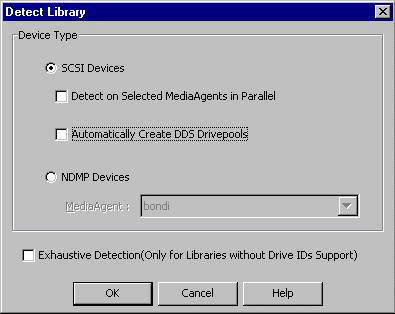
The library and all drives are displayed for the MediaAgent that is connected to the SAN in the Expert Storage Configuration window.
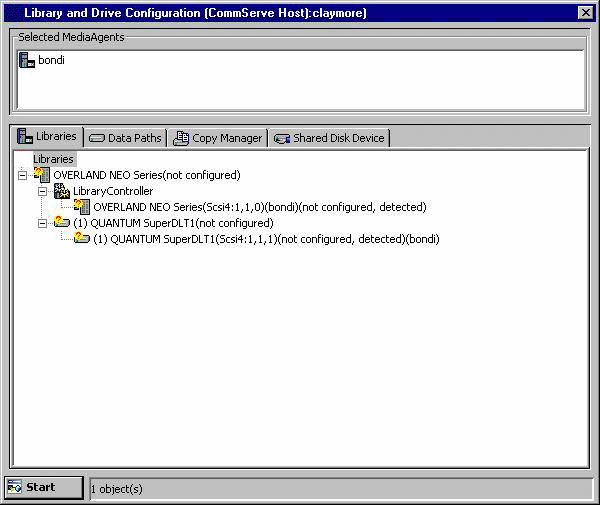
Note
For a Solaris MediaAgent in the SAN environment, the operation will fail to detect devices with SCSI target higher than 15 and/or LUN higher than 7. In a such a situation additional entries must be added for such devices in the wa.conf file. For information on adding these entries see Add Additional Entries in wa.conf File in the Solaris MediaAgent.
If any additional drives are visible on any of the MediaAgents due to incorrect zoning you must do one of the following:
-
Correct the zoning and restart the configuration process.
-
Delete the additional drives before performing the next step.
Note
-
-
Right-click the library and then click Properties.
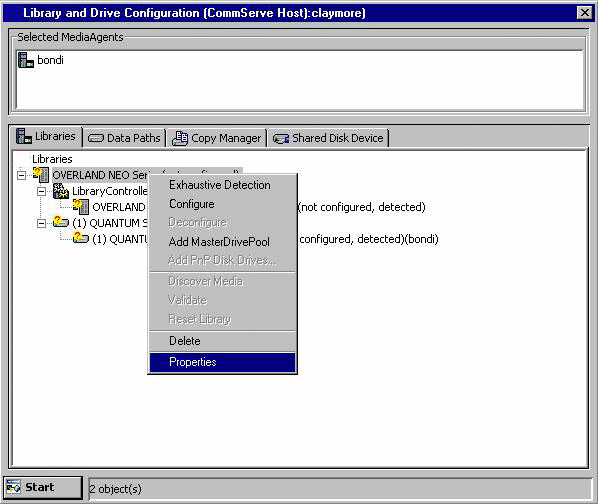
-
From the Library Properties dialog box, select the following option:
- Auto Configure DDS DrivePool: Enable this option to automatically configure the DDS drive pools for MediaAgents sharing these drives.
Optionally, consider the following options and enable or disable it if necessary:
-
Auto Configure Failover Library Controllers: Enable this option to automatically configure the Failover Library Controllers in all the MediaAgents sharing this library.
-
Automatically create storage policy for new Datapaths: Enable this option to automatically create a new Storage Policy when the library is configured.
Click OK.
Note
The option to automatically create/configure DDS DrivePools is not available for NAS-attached libraries; Dynamic Drive Sharing must be configured manually. For instructions on how to configure DDS for NAS-attached libraries, see Configure NAS-attached Libraries Shared Across a SAN.
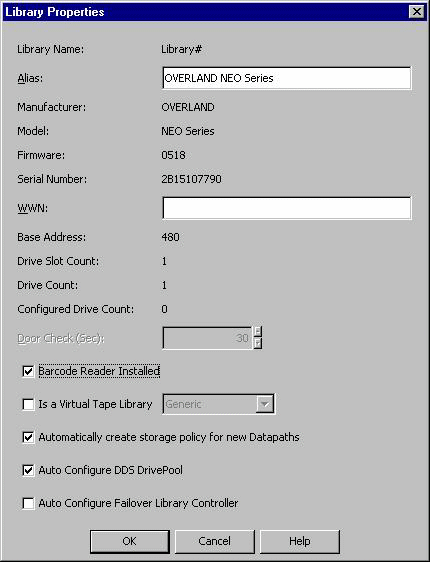
-
Configure the library as described in Configuring Devices. The library is configured and displayed with the configured, detect success status in the Expert Storage Configuration window.
The Library tab provides the physical view of the devices (library and drives).
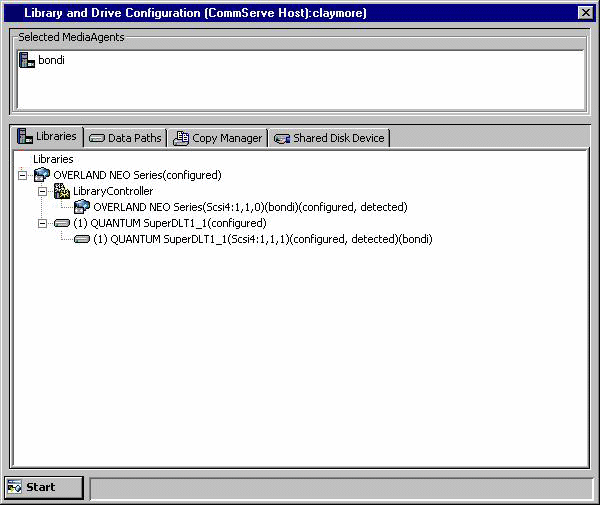
The Data Paths tab provides a logical view of the data path used to access the devices - library, master drive pool, drive pool, drive.
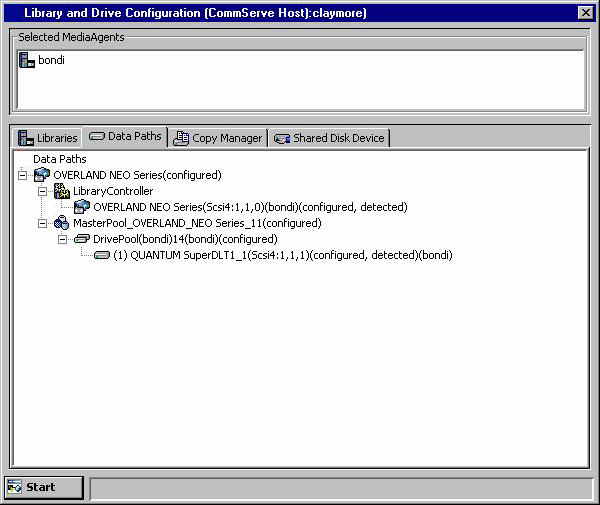
To Automatically Configure the Data Paths in the Storage Policy Copy
-
Optionally, perform the following steps if you want the system to automatically create the alternate data paths in the Storage Policy Copy that was created during the library configuration.
Note
A data path is the combination of MediaAgent, Library, Drive Pool and Scratch Pool used by the storage policy copy to access the library. When you have several MediaAgents accessing a library, you can create a Storage Policy when you configure the library the first time.
For subsequent MediaAgents, you can do the following:
-
Create alternate data paths in the Storage Policy copies associated with the Storage Policy, using the other MediaAgent, Library, Drive Pool and Scratch Pool combinations.
-
Disable the option to automatically create a new storage policy when the library is subsequently configured using another MediaAgent.
Note
-
From the CommCell Console, right click the appropriate library and then click Properties.
-
From the Library Properties dialog box, click the Advanced tab.
-
Enable the Automatically add datapaths for new drivepools configured option.
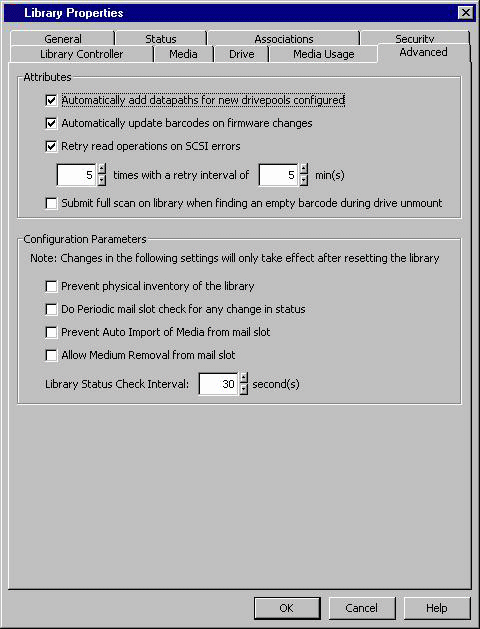
-
From the CommCell Console, right-click the Storage Policy Copy that was created during the library configuration and then click Properties.
-
From the Copy Properties dialog box, click the Data Path Configuration tab.
-
Enable the Automatically add new datapaths option.

-
To Automatically Configure the MediaAgents That Share the Library in SAN
-
Install the library and ensure that the operating system detects the library. (See Driver Configurations for information on how to check this information for various operating systems.)
-
Install the MediaAgent software on all the other computers that will share the library. (See MediaAgent Installation for information on installing the MediaAgent software.)
If you have already installed the MediaAgent software, stop and start the MediaAgent Services on all the MediaAgents sharing this library.
For more information on stopping and starting services, see the following topics:
-
Stopping a Service on Windows
Starting a Service on Windows
-
Stopping a Service on Unix
Starting a Service on Unix
Open the Expert Storage Configuration window and verify that the libraries are configured from all the MediaAgents that share the library.
The Library tab provides the physical view of the devices (library and drives).
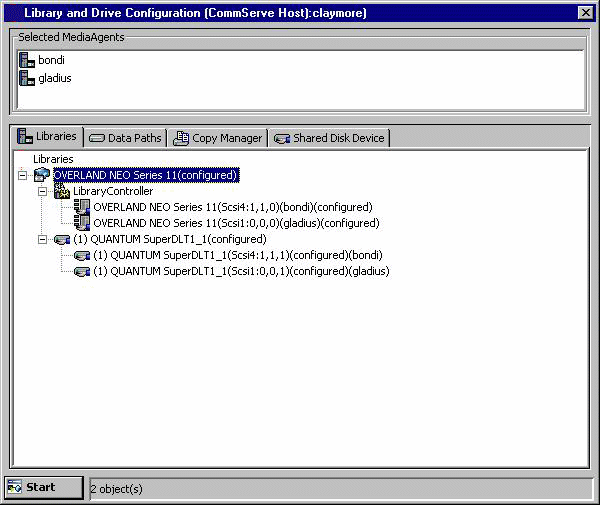
The Data Paths tab provides a logical view of the data path used to access the devices - library, master drive pool, drive pool, drive.

-
Post-Configuration Considerations
After configuring all the libraries, consider disabling the hat the Auto Configure DDS DrivePool and Auto Configure Failover Library Controllers options described in Step 4, if you do not want the system to automatically configure the library whenever a new MediaAgent is installed in the SAN.
Manually Configure Libraries Shared Across a SAN
The following procedure describes the steps involved in configuring a library that is shared across a SAN with DDS, in both the clustered and non-clustered environment. This procedure does not apply to NAS-attached libraries. See Manually Configure NAS-attached Libraries Shared Across a SAN for step-by-step instructions on configuring NAS-attached libraries.
Before You Begin
Check the following before you configure the library in the SAN environment:
-
Hardware is configured according to the conventions detailed in Hardware Configuration Guidelines - Libraries Attached to a SAN.
-
See SAN-Attached Libraries - Best Practices before configuring the library.
-
MediaAgent software is installed on every computer that is connected to the SAN, and that will access the library. The MediaAgent software can be installed on the computers in any order; the installation sequence does not affect the library configuration.
-
Whether the library supports the SCSI 3 drive identification information. To detect whether the library supports SCSI 3, run the ScanScsiTool.exe available in the <Software Installation Path>\Base folder from the command prompt. If SCSI 3 is available, the Drive Identifiers will be displayed under Library Information. For detailed description of SCSI 3 drive identification, see Detection for libraries that support SCSI 3 drive identification information.
-
Note the following for configuring a library attached to the MediaAgent on a cluster:
-
MediaAgent clustering can be supported only for libraries in the SAN environment.
-
Configure the MediaAgents on an active node. The active node takes care of copying the necessary configuration information to the passive nodes.
-
Ensure that both the active and passive nodes are up and running before you begin the configuration.
-
To Manually Configure Libraries Shared Across SAN
-
Display the Expert Storage Configuration window.
In the Select MediaAgents dialog box, select the name of only one MediaAgent that will share the library.

-
Detect the devices. Use Device Detection as required.
If the library supports SCSI 3 drive identification, it is not necessary to perform an exhaustive detection.
The library and all drives are displayed for the MediaAgent that is connected to the SAN in the Expert Storage Configuration window.

Note
MediaAgent in the SAN environment, the operation will fail to detect devices with SCSI target higher than 15 and/or LUN higher than 7. In a such a situation additional entries must be added for such devices in the wa.conf file. For information on adding these entries see Add Additional Entries in wa.conf File in the Solaris MediaAgent.
If any additional drives are visible on any of the MediaAgents due to incorrect zoning you must do one of the following:
-
Correct the zoning and restart the configuration process.
-
Delete the additional drives before performing the next step.
Note
-
-
Configure the library as described in Configuring Devices.
To Automatically Configure the Data Paths in the Storage Policy Copy
-
Optionally, perform the following steps if you want the system to automatically create the alternate data paths in the Storage Policy Copy that was created during the library configuration.
Note
A data path is the combination of MediaAgent, Library, Drive Pool and Scratch Pool used by the storage policy copy to access the library. When you have several MediaAgents accessing a library, you can create a Storage Policy when you configure the library the first time.
For subsequent MediaAgents, you can do the following:
-
Create alternate data paths in the Storage Policy copies associated with the Storage Policy, using the other MediaAgent, Library, Drive Pool and Scratch Pool combinations.
-
Disable the option to automatically create a new storage policy when the library is subsequently configured using another MediaAgent.
Note
-
From the CommCell Console, right click the appropriate library and then click Properties.
-
From the Library Properties dialog box, click the Advanced tab.
-
Enable the Automatically add datapaths for new drivepools configured option.

-
To Configure Other MediaAgents That Share the Library in SAN
-
From the Expert Storage Configuration window, click the Start menu and choose Select MediaAgents.
Select the following MediaAgents:
-
The MediaAgent in which the library is already configured.
-
Other MediaAgent(s) in which you wish to configure the library using DDS.
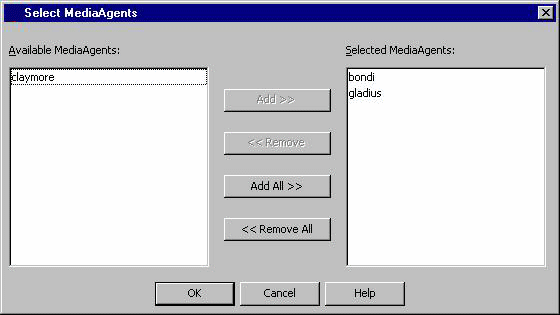
-
-
Click OK in the Information prompt.

-
Detect the devices that are controlled by MediaAgents that will access the library as described in Detect Devices.
In the Detect Library dialog box, select the following options:
-
Detect on Selected MediaAgents in Parallel
-
Automatically create DDS Drivepools
Note
The option to automatically create/configure DDS DrivePools is not available for NAS-attached libraries; Dynamic Drive Sharing must be configured manually. For instructions on how to configure DDS for NAS-attached libraries, see Configure NAS-attached Libraries Shared Across a SAN.
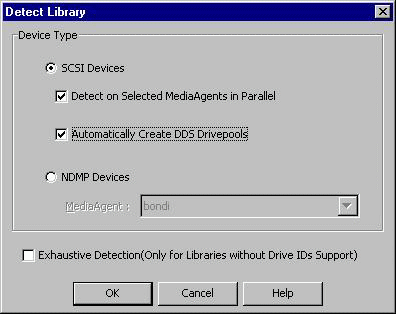
The system detects the drives and automatically displays them with the DDS setup in the Expert Storage Configuration window.
The Library tab provides the physical view of the devices (library and drives).

The Data Paths tab provides a logical view of the data path used to access the devices - library, master drive pool, drive pool, drive.

-
-
Configure the library as described in Configuring Devices.
This will configure the library and the library controllers for the library.
If you do not wish to configure the library controllers on one or more of the MediaAgents, you must delete them before configuring the library.
To delete, right-click the appropriate library controller and then choose Delete. Click OK in the confirmation prompt that appears.
Post Configuration Considerations
If you subsequently add new MediaAgents with visibility to a configured library and drives, the system will automatically configure the libraries and drives in those MediaAgents.
Perform the following steps if you wish to disable the automatic Expert Storage Configuration in such MediaAgents:
From the Expert Storage Configuration window, open the Library Properties dialog box associated with the library you wish to disable automatic configuration.
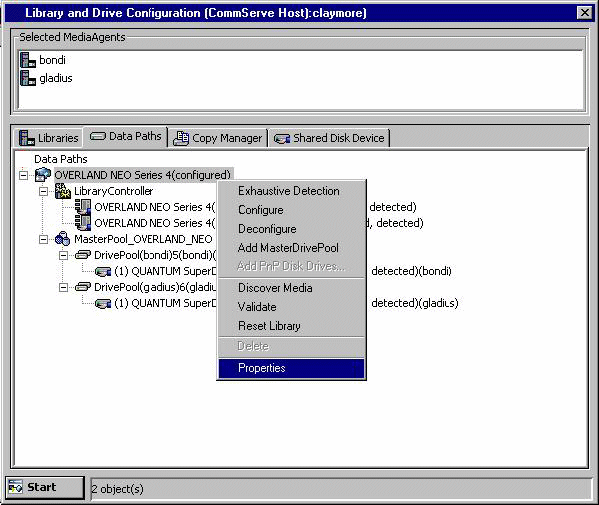
Disable the following options:
-
Auto Configure DDS DrivePool
-
Auto Configure Failover Library Controller

Configure a Library with Mixed Drive Types in SAN
This procedure does not apply to NAS-attached libraries.
Considerations for a Library With Mixed Drive Types in SAN
-
Configure any of the MediaAgents sharing the library as described in Configure a Library with Mixed Drive Types.
-
After configuring the library: Display the Expert Storage Configuration window.
-
Open the Library Properties dialog box and select the following option:
- Auto Configure DDS DrivePool: Enable this option to automatically configure the DDS drive pools for MediaAgents sharing these drives.
Optionally, consider the following options:
-
Auto Configure Failover Library Controllers: Enable this option to automatically configure the Failover Library Controllers in all the MediaAgents sharing this library.
-
Automatically create storage policy for new Datapaths: Disable this option for libraries with mixed drive types.
Click OK.
Note
The option to automatically create/configure DDS DrivePools is not available for NAS-attached libraries; Dynamic Drive Sharing must be configured manually. For instructions on how to configure DDS for NAS-attached libraries, see Configure NAS-attached Libraries Shared Across a SAN.
Automatically Configure Other MediaAgents That Share the Library in SAN
-
Install the library and ensure that the operating system detects the library. (See Driver Configurations for information on how to check this information for various operating systems.)
-
Install the MediaAgent software on all the other computers that will share the library. (See MediaAgent Installation for information on installing the MediaAgent software.)
If you have already installed the MediaAgent software, stop and start the MediaAgent Services on all the MediaAgents sharing this library.
For more information on stopping and starting services, see the following topics:
-
Stopping a Service on Windows
Starting a Service on Windows
Open the Expert Storage Configuration window and verify that the libraries are configured from all the MediaAgents that share the library.
-
Post Configuration Considerations
Consider the following:
-
When you create new storage policies, or have existing storage policies, ensure that the appropriate combination of drive pool and scratch pool are associated with them.
-
Also when you configure the alternate data paths in a storage policy copy, ensure that the same combination of drive pool and scratch pool are added as the alternate paths.